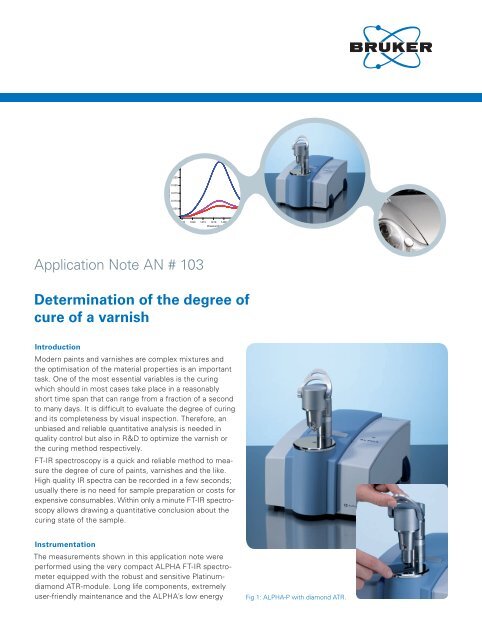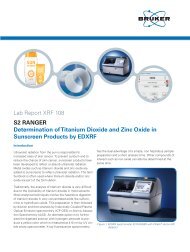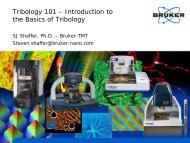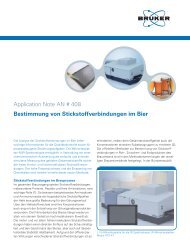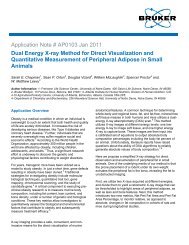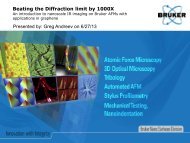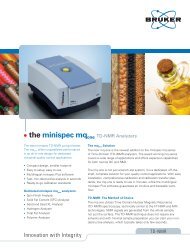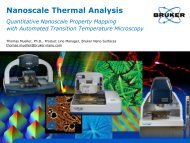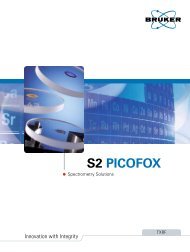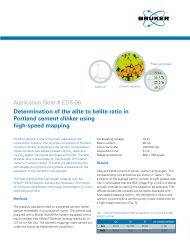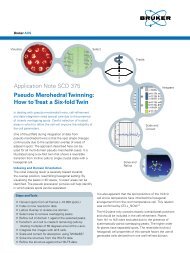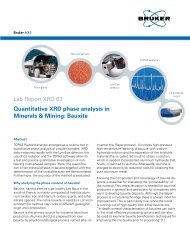Application Note AN # 103 Determination of the degree of ... - Bruker
Application Note AN # 103 Determination of the degree of ... - Bruker
Application Note AN # 103 Determination of the degree of ... - Bruker
You also want an ePaper? Increase the reach of your titles
YUMPU automatically turns print PDFs into web optimized ePapers that Google loves.
0.035<br />
0.030<br />
0.025<br />
Absorbance Units<br />
0.020<br />
0.015<br />
0.010<br />
0.005<br />
0.000<br />
1425<br />
1420<br />
1415<br />
1410<br />
1405<br />
1400<br />
1395<br />
1390<br />
Wavenumber cm-1<br />
<strong>Application</strong> <strong>Note</strong> <strong>AN</strong> # <strong>103</strong><br />
<strong>Determination</strong> <strong>of</strong> <strong>the</strong> <strong>degree</strong> <strong>of</strong><br />
cure <strong>of</strong> a varnish<br />
Introduction<br />
Modern paints and varnishes are complex mixtures and<br />
<strong>the</strong> optimisation <strong>of</strong> <strong>the</strong> material properties is an important<br />
task. One <strong>of</strong> <strong>the</strong> most essential variables is <strong>the</strong> curing<br />
which should in most cases take place in a reasonably<br />
short time span that can range from a fraction <strong>of</strong> a second<br />
to many days. It is difficult to evaluate <strong>the</strong> <strong>degree</strong> <strong>of</strong> curing<br />
and its completeness by visual inspection. Therefore, an<br />
unbiased and reliable quantitative analysis is needed in<br />
quality control but also in R&D to optimize <strong>the</strong> varnish or<br />
<strong>the</strong> curing method respectively.<br />
FT-IR spectroscopy is a quick and reliable method to measure<br />
<strong>the</strong> <strong>degree</strong> <strong>of</strong> cure <strong>of</strong> paints, varnishes and <strong>the</strong> like.<br />
High quality IR spectra can be recorded in a few seconds;<br />
usually <strong>the</strong>re is no need for sample preparation or costs for<br />
expensive consumables. Within only a minute FT-IR spectroscopy<br />
allows drawing a quantitative conclusion about <strong>the</strong><br />
curing state <strong>of</strong> <strong>the</strong> sample.<br />
Instrumentation<br />
The measurements shown in this application note were<br />
performed using <strong>the</strong> very compact ALPHA FT-IR spectrometer<br />
equipped with <strong>the</strong> robust and sensitive Platinumdiamond<br />
ATR-module. Long life components, extremely<br />
user-friendly maintenance and <strong>the</strong> ALPHA´s low energy<br />
Fig 1: ALPHA-P with diamond ATR.
consumption result in incomparably small running costs.<br />
Due to <strong>the</strong> unique design, <strong>the</strong> ALPHA is rugged and<br />
insensitive to external disturbances like e.g. impacts and<br />
vibrations. Therefore, <strong>the</strong> instrument can be moved safely<br />
and, with a weight <strong>of</strong> only 7 kg and its compact dimensions,<br />
also very easily.<br />
Today most routine measurements are mainly performed<br />
with <strong>the</strong> ATR (Attenuated Total Reflection) technique, as<br />
this is much more comfortable to use than <strong>the</strong> conventional<br />
transmission mode. Hereby <strong>the</strong> IR radiation penetrates<br />
slightly (a few microns) into <strong>the</strong> sample surface. The IR<br />
detector <strong>of</strong> <strong>the</strong> FT-IR spectrometer can <strong>the</strong>n measure<br />
<strong>the</strong> absorbance resulting from <strong>the</strong> sample. All types <strong>of</strong><br />
samples (e.g. foils, solids, liquids, powders, pastes, pellets,<br />
slurries, fibres etc.) are just put on <strong>the</strong> accessory before<br />
<strong>the</strong> data acquisition is performed. The full analysis takes<br />
less than a minute, including sampling, measurement and<br />
data evaluation.<br />
The ideal accessory for <strong>the</strong> measurement is <strong>the</strong> Platinum<br />
diamond ATR-module which is extremely robust and very<br />
easy to operate. Its ergonomic one-finger clamp mechanism<br />
allows an extremely easy sampling <strong>of</strong> solid samples.<br />
To provide <strong>the</strong> user an unobstructed access to <strong>the</strong> sampling<br />
area, <strong>the</strong> pressure applicator can be rotated by 360°.<br />
Diamond is a very hard-wearing, chemically inert and<br />
<strong>the</strong>refore ideal material for <strong>the</strong> analysis <strong>of</strong> a wide range <strong>of</strong><br />
samples.<br />
Example applications<br />
In our example application we want to show <strong>the</strong> analysis<br />
<strong>of</strong> an acrylic varnish that builds up a protective cover after<br />
being cured with UV-light. The basic chemical reaction is<br />
described in figure 2; <strong>the</strong> reaction process is a UV-based<br />
radical polymerization where an acrylic ester is polymerized<br />
by <strong>the</strong> opening <strong>of</strong> a C=C double bond.<br />
As a reference two samples are available, one that has<br />
not been exposed to UV-light (0% cure) and one that has<br />
been exposed with an excess <strong>of</strong> UV-light (100% cure). The<br />
spectra were measured with <strong>the</strong> Platinum diamond ATR in<br />
<strong>the</strong> range <strong>of</strong> 4000 - 400 cm -1 with a resolution <strong>of</strong> 4 cm -1 and<br />
with a measurement time <strong>of</strong> about 25 sec./spectrum. At<br />
first glance <strong>the</strong> spectra look very similar as can be seen in<br />
figure 3.<br />
Fig.3: FT-IR spectra <strong>of</strong> <strong>the</strong> acrylic varnish, uncured (blue) and 100 %<br />
cured (red).<br />
Fig.2: Basic reaction scheme <strong>of</strong> an acrylic varnish.<br />
Taking a closer look into <strong>the</strong> fingerprint region it is obvious,<br />
that <strong>the</strong>re are many characteristic differences. Many bands<br />
from <strong>the</strong> C=C double-bonds are reduced upon curing, a<br />
direct consequence from <strong>the</strong> polymerization reaction where<br />
double-bonds are transformed into single-bonds. This effect<br />
is for instance clearly visible at <strong>the</strong> bands located at 1407 cm -1<br />
(resulting from <strong>the</strong> C=C─H in plane deformation vibration)<br />
and 810 cm -1 (resulting from <strong>the</strong> C=C─H out <strong>of</strong> plane<br />
deformation vibration) that are both almost absent after <strong>the</strong><br />
polymerization reaction. Figure 4 shows a magnification <strong>of</strong><br />
<strong>the</strong> region around 1410 cm -1 with <strong>the</strong> bands <strong>of</strong> <strong>the</strong> two reference<br />
spectra and an additional band from a spectrum with<br />
an unknown curing <strong>degree</strong>. Using <strong>the</strong> reference spectra<br />
a simple two point calibration can be set-up based on <strong>the</strong><br />
intensity <strong>of</strong> <strong>the</strong> band at 1410 cm -1 . By applying <strong>the</strong> calibration<br />
on <strong>the</strong> spectrum <strong>of</strong> <strong>the</strong> unknown sample it is possible<br />
to determine <strong>the</strong> <strong>degree</strong> <strong>of</strong> cure <strong>of</strong> <strong>the</strong> unknown sample to<br />
88 %.
Summary<br />
Absorbance Units<br />
0.035<br />
0.030<br />
0.025<br />
0.020<br />
0.015<br />
0.010<br />
0.005<br />
0.000<br />
1425<br />
1420<br />
1415<br />
1410<br />
1405<br />
1400<br />
1395<br />
1390<br />
<strong>Bruker</strong> Optics FT-IR-spectrometer ALPHA with a diamond<br />
ATR module <strong>of</strong>fers a quick and robust measurement<br />
method for <strong>the</strong> <strong>degree</strong> <strong>of</strong> cure <strong>of</strong> polymeric varnishes. The<br />
system allows quantifying <strong>the</strong> <strong>degree</strong> <strong>of</strong> cure by using<br />
simple two-point calibrations. As <strong>the</strong> setup <strong>of</strong> new calibrations<br />
for o<strong>the</strong>r varnishes is quick and straightforward, <strong>the</strong><br />
method is quite suitable to be applied on a wide product<br />
portfolio. Moreover <strong>the</strong> ALPHA system can be used for<br />
additional applications like <strong>the</strong> quality check <strong>of</strong> incoming<br />
goods and analysis <strong>of</strong> product failures. Due to a robust<br />
instrumental setup, simple sample preparation and a user<br />
friendly measurement procedure <strong>the</strong> analysis can even be<br />
performed by untrained users.<br />
Wavenumber cm-1<br />
Figure 4: FT-IR spectra <strong>of</strong> <strong>the</strong> acrylic varnish, uncured (blue) and<br />
100 % cured (red). The magenta colored spectrum results from <strong>the</strong><br />
unknown sample.<br />
www.bruker.com/optics<br />
<strong>Bruker</strong> Optics Inc.<br />
<strong>Bruker</strong> Optik GmbH<br />
<strong>Bruker</strong> Hong Kong Ltd.<br />
Billerica, MA · USA<br />
Phone +1 (978) 439-9899<br />
Fax +1 (978) 663-9177<br />
info@brukeroptics.com<br />
Ettlingen · Deutschland<br />
Phone +49 (7243) 504-2000<br />
Fax +49 (7243) 504-2050<br />
info@brukeroptics.de<br />
Hong Kong<br />
Phone +852 2796-6100<br />
Fax +852 2796-6109<br />
hk@brukeroptics.com.hk<br />
<strong>Bruker</strong> Optics is continually improving its products and reserves <strong>the</strong> right to change specifications without notice.<br />
© 2010 <strong>Bruker</strong> Optics BOPT-4000482-01


